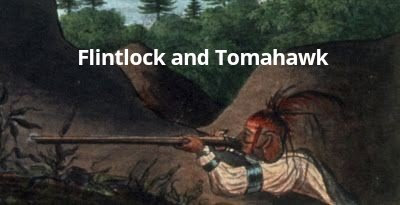Interesting piece
here about the uniform of this unit led by ex Butler's Ranger
Caldwell. Also there's a photo on this Parks Canada site
hereAlso read about
Sagaunash - his son and Metis warrior 'Billy Caldwell'.
The wiki on Canadian units of the War of 1812 states
Caldwell's Western Rangers
Known as Caldwell's Rangers, after their commander, noted Loyalist and Indian trader William Caldwell.[22] The unit was a rather small one, probably not more than fifty men. Nominally organised as two companies, they often worked in conjunction with the Indian Department and fought dispersed alongside the Indians (chiefly the Ojibwe, Wyandotte and Pottowottomi). The unit, or parts of it, fought at the Battle of Moraviantown, the Battle of Longwoods, the Battle of Lundy's Lane and in several actions on the Niagara peninsula.
There is little authenticated documentation as to the clothing and equipment carried by the Rangers. It is known that the rangers were issued a "bucket cap" (probably a cut down infantry shako without the brass plate or hackle), grey woollen trousers and a green woollen tunic, and a black leather bayonet belt and cartridge box. This equipment was issued only once; after that, they were told to re-supply themselves from the enemy. In summer, they would wear white cotton instead of woollen trousers.
It is not known with which model musket they were issued, although some scholars have suggested that they would have been captured American Springfield Model 1795 Musket (British forces under Isaac Brock captured over 1200 Muskets and over 200 Rifles at Detroit) while some others contend they may have used trade muskets instead. The Rangers found that the standard infantry bayonet was too cumbersome for bush fighting and often used hatchets (tomahawks) instead.
The Rangers were recruited locally from Essex County and enrolled into the militia, but not permitted to quit the British service at their leisure as sedentary Militia could.
Fort Malden National Historic Site (Canada) has in recent years employed summer students for the re-created unit at the Park and regional re-enactments. There is also a Modern Re-enacting unit that recreates the Rangers; they are based out of Amherstburg, Ontario and work in conjunction with Fort Malden.

 Another thing I used to do a lot in the late 90s was write pieces for living history magazines on the French and Indian group I was running. There were three glossy mags at that time - this one was the first and this piece was in the launch issue - it only ran to a couple. I'm not sure if this piece actually makes any sense - I think by this time I had written so many bits on the F&I scene I had lost the plot a little. My sister took the photos at Bath. You may wonder how many people you get from an article like this - well none of course but with other articles in other mags it created a surge effect that eventually wore people down to thinking maybe everyone is actually getting into the F&I ... good times.
Another thing I used to do a lot in the late 90s was write pieces for living history magazines on the French and Indian group I was running. There were three glossy mags at that time - this one was the first and this piece was in the launch issue - it only ran to a couple. I'm not sure if this piece actually makes any sense - I think by this time I had written so many bits on the F&I scene I had lost the plot a little. My sister took the photos at Bath. You may wonder how many people you get from an article like this - well none of course but with other articles in other mags it created a surge effect that eventually wore people down to thinking maybe everyone is actually getting into the F&I ... good times.














































.jpg)





